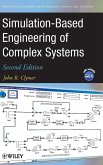Systems of Systems
Herausgegeben von Luzeaux, Dominique; Ruault, Jean-René
Systems of Systems
Herausgegeben von Luzeaux, Dominique; Ruault, Jean-René
- Gebundenes Buch
- Merkliste
- Auf die Merkliste
- Bewerten Bewerten
- Teilen
- Produkt teilen
- Produkterinnerung
- Produkterinnerung
In recent years, the systems designed to support activity in thefields of banking, health, transportation, space, aeronautics,defense, etc. have become increasingly larger and more complex.With the growing maturity of information and communicationtechnologies, systems have been interconnected within growingnetworks, yielding new capabilities and services through thecombination of system functionalities. This has led to a furtherincreasing complexity that has to be managed in order to takeadvantage of these system integrations. The book is divided into two parts. The first partaddresses the…mehr
Andere Kunden interessierten sich auch für
![System of Systems Engineering System of Systems Engineering]() System of Systems Engineering177,99 €
System of Systems Engineering177,99 €![Model Based Systems Engineering Model Based Systems Engineering]() Patrice MicouinModel Based Systems Engineering169,99 €
Patrice MicouinModel Based Systems Engineering169,99 €![Verification, Validation, and Testing of Engineered Systems Verification, Validation, and Testing of Engineered Systems]() Avner EngelVerification, Validation, and Testing of Engineered Systems194,99 €
Avner EngelVerification, Validation, and Testing of Engineered Systems194,99 €![Simulation-Based Engineering of Complex Systems Simulation-Based Engineering of Complex Systems]() John R. ClymerSimulation-Based Engineering of Complex Systems188,99 €
John R. ClymerSimulation-Based Engineering of Complex Systems188,99 €![Contemporary Issues in Systems Science and Engineering Contemporary Issues in Systems Science and Engineering]() MengChu ZhouContemporary Issues in Systems Science and Engineering162,99 €
MengChu ZhouContemporary Issues in Systems Science and Engineering162,99 €![Systems Engineering Systems Engineering]() Derek K. HitchinsSystems Engineering162,99 €
Derek K. HitchinsSystems Engineering162,99 €![Identification of Physical Systems Identification of Physical Systems]() Rajamani DoraiswamiIdentification of Physical Systems126,99 €
Rajamani DoraiswamiIdentification of Physical Systems126,99 €-
-
-
In recent years, the systems designed to support activity in thefields of banking, health, transportation, space, aeronautics,defense, etc. have become increasingly larger and more complex.With the growing maturity of information and communicationtechnologies, systems have been interconnected within growingnetworks, yielding new capabilities and services through thecombination of system functionalities. This has led to a furtherincreasing complexity that has to be managed in order to takeadvantage of these system integrations.
The book is divided into two parts. The first partaddresses the concept and practical illustrations of a"system of systems" and is a multidisciplinaryintroduction to the notion of a "systems of systems"that is discussed extensively in the current scientific andtechnical literature. After a critical comparison of the differentdefinitions and a range of various practical illustrations, thispart provides answers to key questions such as what a system ofsystems is and how its complexity can be mastered. Thesecond part, described as "systems-of-systems engineering:methods and tools", focuses on both engineering and modeling,and standardization issues that are critical to deal with the keysteps in systems of systems engineering: namely elicitingstakeholder needs, architecture optimization, integration ofconstituent systems, qualification, and utilization.
Hinweis: Dieser Artikel kann nur an eine deutsche Lieferadresse ausgeliefert werden.
The book is divided into two parts. The first partaddresses the concept and practical illustrations of a"system of systems" and is a multidisciplinaryintroduction to the notion of a "systems of systems"that is discussed extensively in the current scientific andtechnical literature. After a critical comparison of the differentdefinitions and a range of various practical illustrations, thispart provides answers to key questions such as what a system ofsystems is and how its complexity can be mastered. Thesecond part, described as "systems-of-systems engineering:methods and tools", focuses on both engineering and modeling,and standardization issues that are critical to deal with the keysteps in systems of systems engineering: namely elicitingstakeholder needs, architecture optimization, integration ofconstituent systems, qualification, and utilization.
Hinweis: Dieser Artikel kann nur an eine deutsche Lieferadresse ausgeliefert werden.
Produktdetails
- Produktdetails
- ISTE
- Verlag: ISTE / Wiley & Sons
- 1. Auflage
- Seitenzahl: 544
- Erscheinungstermin: 15. März 2010
- Englisch
- Abmessung: 236mm x 157mm x 36mm
- Gewicht: 930g
- ISBN-13: 9781848211643
- ISBN-10: 1848211643
- Artikelnr.: 30602282
- Herstellerkennzeichnung
- Libri GmbH
- Europaallee 1
- 36244 Bad Hersfeld
- gpsr@libri.de
- ISTE
- Verlag: ISTE / Wiley & Sons
- 1. Auflage
- Seitenzahl: 544
- Erscheinungstermin: 15. März 2010
- Englisch
- Abmessung: 236mm x 157mm x 36mm
- Gewicht: 930g
- ISBN-13: 9781848211643
- ISBN-10: 1848211643
- Artikelnr.: 30602282
- Herstellerkennzeichnung
- Libri GmbH
- Europaallee 1
- 36244 Bad Hersfeld
- gpsr@libri.de
Dominique Luzeaux graduated from École Polytechnique (1987), École Nationale Supérieure des Techniques Avancées (1989), completed a PhD from University Paris XI (1991) and a Faculty Habilitation in 2001. He has been employed by the Ministry of Defense for over 20 years. He was Director of the Complex System Engineering Department from 2002 to 2004, and Chief Information Officer from 2005 to 2007. He is currently Deputy Director of the service in charge of the C4ISR (Computerized Command, Control, Communications, Intelligence, Surveillance and Reconnaissance) programs. He has written over 60 articles in international conferences and journals, and teaches robotics, theoretical computer science and system engineering at graduate level. He has co-authored a book on nanotechnology and Microsystems published in 2007 by Éditions du Félin. Jean-René Ruault completed a master degree in experimental social psychology, and a graduate-level training in industrial engineering. After over 10 years as a consultant on software engineering and human-computer interaction, he was hired in 2004 by the Ministry of Defense as an expert in systems engineering, standardization and human factors. He has published several articles on system engineering and human-computer interactions, and was co-chairman of the ERGO-IA'06 conference.
Author Biographies xv
Introduction xix
PART 1. SYSTEMS OF SYSTEMS, CONCEPTS AND PRACTICAL ILLUSTRATIONS 1
Chapter 1. Systems of Systems: From Concept to Actual Development 3
Dominique LUZEAUX
1.1. Network omnipresence creating a worldwide environment 3
1.2. Increasing complexity of the environment 5
1.3. Towards a definition of the concept of system of systems 11
1.4. Control of the system of systems 34
1.5. Tools for the control of the system of systems 47
1.6. The need for standardization 56
1.7. The human factor in systems of systems 58
1.8. Budgetary aspects of the systems of systems 68
1.9. The need for governance 70
1.10. Conclusion 75
1.11. Appendix: system of systems' definitions in literature. 77
1.12. Bibliography 84
Chapter 2. Emergence and Complexity of Systems of Systems 89
Patrice MICOUIN
2.1. Introduction 89
2.2. Matter and shape 90
2.3. Systems 92
2.4. Genesis of concrete systems 99
2.5. Complexity of systems of systems 107
2.6. Systems of systems engineering 111
2.7. Conclusion 115
2.8. Bibliography 116
Chapter 3. Contractual Aspects of the Acquisition and Use of Systems of
Systems 119
Danièle VÉRET
3.1. Introduction 119
3.2. An integrated set of components of various natures 121
3.3. Combining people with diversified skills and their contributions 125
3.4. Commitments to coordinate 130
3.5. Ownership rights 142
3.6. The most adapted legal strategies 147
3.7. Conclusion 148
Chapter 4. The Human Factor within the Context of Systems of Systems 149
Jean-René RUAULT
4.1. Introduction 149
4.2. Definition and epistemological aspects 150
4.3. The issue 154
4.4. Current human factors in systems engineering 160
4.5. The organizations' complexity from the standpoint of social sciences:
impacts on the systems of systems 166
4.6. Social sciences implemented within the context of systems of systems
192
4.7. Recognizable good practices in the field of organizations 201
4.8. Conclusion 202
4.9. Acknowledgments 203
4.10. Bibliography 203
Chapter 5. Space Communication and Observation System of Systems 207
Frédéric PRADEILLES and Dominique LUZEAUX
5.1. The dual context of omnipresent information and the commoditization of
space 207
5.2. The technical view: an interconnection of ground-based and space-borne
systems 209
5.3. Search for functionality and capacity 213
5.4. A logic of exchange on an international scale 214
5.5. Conclusion 220
5.6. Bibliography 221
Chapter 6. Intelligent Transport Systems 223
Michel CHAVRET
6.1. The field of intelligent transport 223
6.2. ACTIF 226
6.3. Practical application 230
6.4. Conclusion 234
6.5. Bibliography 234
Chapter 7. Systems of Systems in the Healthcare Field 235
Jean-René RUAULT
7.1. Introduction 235
7.2. From capability challenges to the design of systems of systems 236
7.3. Personal service, the main characteristic of systems within the
healthcare field 239
7.4. Coordination of the medical and paramedical agents, in hospitals and
in private practices 242
7.5. The development of information technologies and their
interoperability, heart of the healthcare networks issue 245
7.6. Difficulties encountered 256
7.7. Conclusion 258
7.8. Acknowledgments 258
7.9. Bibliography 259
Chapter 8. Critical Infrastructure Protection 261
Jean-Luc ZOLESIO
8.1. General context of critical infrastructure protection 261
8.2. Protection requirements 266
8.3. Security systems of the future 272
8.4. The human factor 285
8.5. Conclusion 290
Chapter 9. Globalization and Systemic Impacts 291
Dominique LUZEAUX, Jean-René RUAULT and Lui KAM
9.1. Introduction 291
9.2. System of systems "globalization" 292
9.3. Beyond the concepts of systems 309
9.4. Globalization's impact on systems of systems engineering 312
9.5. Conclusion 316
9.6. Appendix: a summary of the properties of nonlinear dynamic systems 317
9.7. Bibliography 318
PART 2. SYSTEMS OF SYSTEMS ENGINEERING, METHODS, STANDARDS AND TOOLS 321
Chapter 10. Methods and Tools for Systems of Systems Engineering 323
Dominique LUZEAUX
10.1. Systems of systems engineering: from the control of complexity to the
necessity of a model-driven approach 323
10.2. Architecture 326
10.3. From architecture to detailed design: reference architectures 331
10.4. Requirement traceability and engineering tools 338
10.5. Reverse engineering and impact studies 342
10.6. Distributed simulation tools for model engineering 344
10.7. Global control of operational security via testability 346
10.8. Towards a virtuous circle of simulation-tests to control the tests
352
10.9. Collaborative work tools 357
10.10. Conclusion 360
10.11. Acknowledgements 361
10.12. Bibliography 362
Chapter 11. Model-driven Design and Simulation 363
Lui KAM
11.1. General points 363
11.2. A few definitions 365
11.3. Model-driven engineering 378
11.4. Feedback 385
11.5. Conclusion and perspectives 392
11.6. Bibliography 394
Chapter 12. Standardization in the Field of Systems and Systems of Systems
Engineering 399
Jean-René RUAULT and Jean-Pierre MEINADIER
12.1. Introduction 399
12.2. Example of the importance of standards in the interoperability of
systems and systems of systems 400
12.3. Standards used in the field of systems and systems of systems 403
12.4. Application and adaptation of system engineering standards in the
context of systems of systems 433
12.5. Implementation of standards in the context of systems of systems 438
12.6. Conclusion 439
12.7. Acknowledgements 439
12.8. Appendix A. Standard relative to business process modeling 439
12.9. Appendix B. Standard relative to the Web services business process
execution language 443
12.10. Appendix C. Ontology definition metamodel specification 444
12.11. Appendix D. UML profile for DoDAF/MODAF (USA Department of Defense
and UK Ministry of Defense
Architecture Framework) 446
12.12. Appendix E. Standard relative to software-intensive systems
architecture 451
12.13. Appendix F. Unified modeling language 454
12.14. Appendix G. Systems modeling language 457
12.15. Appendix H. Good practices of IT service management, ITIL 461
12.16. Appendix I. Standard relative to IT services management 464
12.17. Appendix J. Software engineering - Product quality 466
12.18. Appendix J.1. Standard ISO 9126, part 1, quality model 466
12.19. Appendix J.2. Standard ISO 9126, part 3, internal metrics 468
12.20. Appendix K. Standard on software product quality requirements and
evaluation 468
12.21. Appendix L. Standard on the common criteria for IT security
evaluation 469
12.22. Appendix M. Standard relative to a system's life cycle process 473
12.23. Appendix N. Standard relative to the processes for engineering a
system 482
12.24. Appendix O. Standard for the application and management of the
systems engineering process 487
12.25. Appendix P. Standard relative to software life cycle processes 494
12.26. Appendix Q. Standard relative to software measurement process 499
12.27. Appendix R. Standard relative to software product evaluation 500
12.28. Appendix S. Standard on systems engineering, product and design data
exchange 504
12.29. Appendix T. Standard on the exchange of product model data, products
life cycle support 507
12.30. Bibliography 510
Conclusion 513
List of Authors 519
Index 521
Introduction xix
PART 1. SYSTEMS OF SYSTEMS, CONCEPTS AND PRACTICAL ILLUSTRATIONS 1
Chapter 1. Systems of Systems: From Concept to Actual Development 3
Dominique LUZEAUX
1.1. Network omnipresence creating a worldwide environment 3
1.2. Increasing complexity of the environment 5
1.3. Towards a definition of the concept of system of systems 11
1.4. Control of the system of systems 34
1.5. Tools for the control of the system of systems 47
1.6. The need for standardization 56
1.7. The human factor in systems of systems 58
1.8. Budgetary aspects of the systems of systems 68
1.9. The need for governance 70
1.10. Conclusion 75
1.11. Appendix: system of systems' definitions in literature. 77
1.12. Bibliography 84
Chapter 2. Emergence and Complexity of Systems of Systems 89
Patrice MICOUIN
2.1. Introduction 89
2.2. Matter and shape 90
2.3. Systems 92
2.4. Genesis of concrete systems 99
2.5. Complexity of systems of systems 107
2.6. Systems of systems engineering 111
2.7. Conclusion 115
2.8. Bibliography 116
Chapter 3. Contractual Aspects of the Acquisition and Use of Systems of
Systems 119
Danièle VÉRET
3.1. Introduction 119
3.2. An integrated set of components of various natures 121
3.3. Combining people with diversified skills and their contributions 125
3.4. Commitments to coordinate 130
3.5. Ownership rights 142
3.6. The most adapted legal strategies 147
3.7. Conclusion 148
Chapter 4. The Human Factor within the Context of Systems of Systems 149
Jean-René RUAULT
4.1. Introduction 149
4.2. Definition and epistemological aspects 150
4.3. The issue 154
4.4. Current human factors in systems engineering 160
4.5. The organizations' complexity from the standpoint of social sciences:
impacts on the systems of systems 166
4.6. Social sciences implemented within the context of systems of systems
192
4.7. Recognizable good practices in the field of organizations 201
4.8. Conclusion 202
4.9. Acknowledgments 203
4.10. Bibliography 203
Chapter 5. Space Communication and Observation System of Systems 207
Frédéric PRADEILLES and Dominique LUZEAUX
5.1. The dual context of omnipresent information and the commoditization of
space 207
5.2. The technical view: an interconnection of ground-based and space-borne
systems 209
5.3. Search for functionality and capacity 213
5.4. A logic of exchange on an international scale 214
5.5. Conclusion 220
5.6. Bibliography 221
Chapter 6. Intelligent Transport Systems 223
Michel CHAVRET
6.1. The field of intelligent transport 223
6.2. ACTIF 226
6.3. Practical application 230
6.4. Conclusion 234
6.5. Bibliography 234
Chapter 7. Systems of Systems in the Healthcare Field 235
Jean-René RUAULT
7.1. Introduction 235
7.2. From capability challenges to the design of systems of systems 236
7.3. Personal service, the main characteristic of systems within the
healthcare field 239
7.4. Coordination of the medical and paramedical agents, in hospitals and
in private practices 242
7.5. The development of information technologies and their
interoperability, heart of the healthcare networks issue 245
7.6. Difficulties encountered 256
7.7. Conclusion 258
7.8. Acknowledgments 258
7.9. Bibliography 259
Chapter 8. Critical Infrastructure Protection 261
Jean-Luc ZOLESIO
8.1. General context of critical infrastructure protection 261
8.2. Protection requirements 266
8.3. Security systems of the future 272
8.4. The human factor 285
8.5. Conclusion 290
Chapter 9. Globalization and Systemic Impacts 291
Dominique LUZEAUX, Jean-René RUAULT and Lui KAM
9.1. Introduction 291
9.2. System of systems "globalization" 292
9.3. Beyond the concepts of systems 309
9.4. Globalization's impact on systems of systems engineering 312
9.5. Conclusion 316
9.6. Appendix: a summary of the properties of nonlinear dynamic systems 317
9.7. Bibliography 318
PART 2. SYSTEMS OF SYSTEMS ENGINEERING, METHODS, STANDARDS AND TOOLS 321
Chapter 10. Methods and Tools for Systems of Systems Engineering 323
Dominique LUZEAUX
10.1. Systems of systems engineering: from the control of complexity to the
necessity of a model-driven approach 323
10.2. Architecture 326
10.3. From architecture to detailed design: reference architectures 331
10.4. Requirement traceability and engineering tools 338
10.5. Reverse engineering and impact studies 342
10.6. Distributed simulation tools for model engineering 344
10.7. Global control of operational security via testability 346
10.8. Towards a virtuous circle of simulation-tests to control the tests
352
10.9. Collaborative work tools 357
10.10. Conclusion 360
10.11. Acknowledgements 361
10.12. Bibliography 362
Chapter 11. Model-driven Design and Simulation 363
Lui KAM
11.1. General points 363
11.2. A few definitions 365
11.3. Model-driven engineering 378
11.4. Feedback 385
11.5. Conclusion and perspectives 392
11.6. Bibliography 394
Chapter 12. Standardization in the Field of Systems and Systems of Systems
Engineering 399
Jean-René RUAULT and Jean-Pierre MEINADIER
12.1. Introduction 399
12.2. Example of the importance of standards in the interoperability of
systems and systems of systems 400
12.3. Standards used in the field of systems and systems of systems 403
12.4. Application and adaptation of system engineering standards in the
context of systems of systems 433
12.5. Implementation of standards in the context of systems of systems 438
12.6. Conclusion 439
12.7. Acknowledgements 439
12.8. Appendix A. Standard relative to business process modeling 439
12.9. Appendix B. Standard relative to the Web services business process
execution language 443
12.10. Appendix C. Ontology definition metamodel specification 444
12.11. Appendix D. UML profile for DoDAF/MODAF (USA Department of Defense
and UK Ministry of Defense
Architecture Framework) 446
12.12. Appendix E. Standard relative to software-intensive systems
architecture 451
12.13. Appendix F. Unified modeling language 454
12.14. Appendix G. Systems modeling language 457
12.15. Appendix H. Good practices of IT service management, ITIL 461
12.16. Appendix I. Standard relative to IT services management 464
12.17. Appendix J. Software engineering - Product quality 466
12.18. Appendix J.1. Standard ISO 9126, part 1, quality model 466
12.19. Appendix J.2. Standard ISO 9126, part 3, internal metrics 468
12.20. Appendix K. Standard on software product quality requirements and
evaluation 468
12.21. Appendix L. Standard on the common criteria for IT security
evaluation 469
12.22. Appendix M. Standard relative to a system's life cycle process 473
12.23. Appendix N. Standard relative to the processes for engineering a
system 482
12.24. Appendix O. Standard for the application and management of the
systems engineering process 487
12.25. Appendix P. Standard relative to software life cycle processes 494
12.26. Appendix Q. Standard relative to software measurement process 499
12.27. Appendix R. Standard relative to software product evaluation 500
12.28. Appendix S. Standard on systems engineering, product and design data
exchange 504
12.29. Appendix T. Standard on the exchange of product model data, products
life cycle support 507
12.30. Bibliography 510
Conclusion 513
List of Authors 519
Index 521
Author Biographies xv
Introduction xix
PART 1. SYSTEMS OF SYSTEMS, CONCEPTS AND PRACTICAL ILLUSTRATIONS 1
Chapter 1. Systems of Systems: From Concept to Actual Development 3
Dominique LUZEAUX
1.1. Network omnipresence creating a worldwide environment 3
1.2. Increasing complexity of the environment 5
1.3. Towards a definition of the concept of system of systems 11
1.4. Control of the system of systems 34
1.5. Tools for the control of the system of systems 47
1.6. The need for standardization 56
1.7. The human factor in systems of systems 58
1.8. Budgetary aspects of the systems of systems 68
1.9. The need for governance 70
1.10. Conclusion 75
1.11. Appendix: system of systems' definitions in literature. 77
1.12. Bibliography 84
Chapter 2. Emergence and Complexity of Systems of Systems 89
Patrice MICOUIN
2.1. Introduction 89
2.2. Matter and shape 90
2.3. Systems 92
2.4. Genesis of concrete systems 99
2.5. Complexity of systems of systems 107
2.6. Systems of systems engineering 111
2.7. Conclusion 115
2.8. Bibliography 116
Chapter 3. Contractual Aspects of the Acquisition and Use of Systems of
Systems 119
Danièle VÉRET
3.1. Introduction 119
3.2. An integrated set of components of various natures 121
3.3. Combining people with diversified skills and their contributions 125
3.4. Commitments to coordinate 130
3.5. Ownership rights 142
3.6. The most adapted legal strategies 147
3.7. Conclusion 148
Chapter 4. The Human Factor within the Context of Systems of Systems 149
Jean-René RUAULT
4.1. Introduction 149
4.2. Definition and epistemological aspects 150
4.3. The issue 154
4.4. Current human factors in systems engineering 160
4.5. The organizations' complexity from the standpoint of social sciences:
impacts on the systems of systems 166
4.6. Social sciences implemented within the context of systems of systems
192
4.7. Recognizable good practices in the field of organizations 201
4.8. Conclusion 202
4.9. Acknowledgments 203
4.10. Bibliography 203
Chapter 5. Space Communication and Observation System of Systems 207
Frédéric PRADEILLES and Dominique LUZEAUX
5.1. The dual context of omnipresent information and the commoditization of
space 207
5.2. The technical view: an interconnection of ground-based and space-borne
systems 209
5.3. Search for functionality and capacity 213
5.4. A logic of exchange on an international scale 214
5.5. Conclusion 220
5.6. Bibliography 221
Chapter 6. Intelligent Transport Systems 223
Michel CHAVRET
6.1. The field of intelligent transport 223
6.2. ACTIF 226
6.3. Practical application 230
6.4. Conclusion 234
6.5. Bibliography 234
Chapter 7. Systems of Systems in the Healthcare Field 235
Jean-René RUAULT
7.1. Introduction 235
7.2. From capability challenges to the design of systems of systems 236
7.3. Personal service, the main characteristic of systems within the
healthcare field 239
7.4. Coordination of the medical and paramedical agents, in hospitals and
in private practices 242
7.5. The development of information technologies and their
interoperability, heart of the healthcare networks issue 245
7.6. Difficulties encountered 256
7.7. Conclusion 258
7.8. Acknowledgments 258
7.9. Bibliography 259
Chapter 8. Critical Infrastructure Protection 261
Jean-Luc ZOLESIO
8.1. General context of critical infrastructure protection 261
8.2. Protection requirements 266
8.3. Security systems of the future 272
8.4. The human factor 285
8.5. Conclusion 290
Chapter 9. Globalization and Systemic Impacts 291
Dominique LUZEAUX, Jean-René RUAULT and Lui KAM
9.1. Introduction 291
9.2. System of systems "globalization" 292
9.3. Beyond the concepts of systems 309
9.4. Globalization's impact on systems of systems engineering 312
9.5. Conclusion 316
9.6. Appendix: a summary of the properties of nonlinear dynamic systems 317
9.7. Bibliography 318
PART 2. SYSTEMS OF SYSTEMS ENGINEERING, METHODS, STANDARDS AND TOOLS 321
Chapter 10. Methods and Tools for Systems of Systems Engineering 323
Dominique LUZEAUX
10.1. Systems of systems engineering: from the control of complexity to the
necessity of a model-driven approach 323
10.2. Architecture 326
10.3. From architecture to detailed design: reference architectures 331
10.4. Requirement traceability and engineering tools 338
10.5. Reverse engineering and impact studies 342
10.6. Distributed simulation tools for model engineering 344
10.7. Global control of operational security via testability 346
10.8. Towards a virtuous circle of simulation-tests to control the tests
352
10.9. Collaborative work tools 357
10.10. Conclusion 360
10.11. Acknowledgements 361
10.12. Bibliography 362
Chapter 11. Model-driven Design and Simulation 363
Lui KAM
11.1. General points 363
11.2. A few definitions 365
11.3. Model-driven engineering 378
11.4. Feedback 385
11.5. Conclusion and perspectives 392
11.6. Bibliography 394
Chapter 12. Standardization in the Field of Systems and Systems of Systems
Engineering 399
Jean-René RUAULT and Jean-Pierre MEINADIER
12.1. Introduction 399
12.2. Example of the importance of standards in the interoperability of
systems and systems of systems 400
12.3. Standards used in the field of systems and systems of systems 403
12.4. Application and adaptation of system engineering standards in the
context of systems of systems 433
12.5. Implementation of standards in the context of systems of systems 438
12.6. Conclusion 439
12.7. Acknowledgements 439
12.8. Appendix A. Standard relative to business process modeling 439
12.9. Appendix B. Standard relative to the Web services business process
execution language 443
12.10. Appendix C. Ontology definition metamodel specification 444
12.11. Appendix D. UML profile for DoDAF/MODAF (USA Department of Defense
and UK Ministry of Defense
Architecture Framework) 446
12.12. Appendix E. Standard relative to software-intensive systems
architecture 451
12.13. Appendix F. Unified modeling language 454
12.14. Appendix G. Systems modeling language 457
12.15. Appendix H. Good practices of IT service management, ITIL 461
12.16. Appendix I. Standard relative to IT services management 464
12.17. Appendix J. Software engineering - Product quality 466
12.18. Appendix J.1. Standard ISO 9126, part 1, quality model 466
12.19. Appendix J.2. Standard ISO 9126, part 3, internal metrics 468
12.20. Appendix K. Standard on software product quality requirements and
evaluation 468
12.21. Appendix L. Standard on the common criteria for IT security
evaluation 469
12.22. Appendix M. Standard relative to a system's life cycle process 473
12.23. Appendix N. Standard relative to the processes for engineering a
system 482
12.24. Appendix O. Standard for the application and management of the
systems engineering process 487
12.25. Appendix P. Standard relative to software life cycle processes 494
12.26. Appendix Q. Standard relative to software measurement process 499
12.27. Appendix R. Standard relative to software product evaluation 500
12.28. Appendix S. Standard on systems engineering, product and design data
exchange 504
12.29. Appendix T. Standard on the exchange of product model data, products
life cycle support 507
12.30. Bibliography 510
Conclusion 513
List of Authors 519
Index 521
Introduction xix
PART 1. SYSTEMS OF SYSTEMS, CONCEPTS AND PRACTICAL ILLUSTRATIONS 1
Chapter 1. Systems of Systems: From Concept to Actual Development 3
Dominique LUZEAUX
1.1. Network omnipresence creating a worldwide environment 3
1.2. Increasing complexity of the environment 5
1.3. Towards a definition of the concept of system of systems 11
1.4. Control of the system of systems 34
1.5. Tools for the control of the system of systems 47
1.6. The need for standardization 56
1.7. The human factor in systems of systems 58
1.8. Budgetary aspects of the systems of systems 68
1.9. The need for governance 70
1.10. Conclusion 75
1.11. Appendix: system of systems' definitions in literature. 77
1.12. Bibliography 84
Chapter 2. Emergence and Complexity of Systems of Systems 89
Patrice MICOUIN
2.1. Introduction 89
2.2. Matter and shape 90
2.3. Systems 92
2.4. Genesis of concrete systems 99
2.5. Complexity of systems of systems 107
2.6. Systems of systems engineering 111
2.7. Conclusion 115
2.8. Bibliography 116
Chapter 3. Contractual Aspects of the Acquisition and Use of Systems of
Systems 119
Danièle VÉRET
3.1. Introduction 119
3.2. An integrated set of components of various natures 121
3.3. Combining people with diversified skills and their contributions 125
3.4. Commitments to coordinate 130
3.5. Ownership rights 142
3.6. The most adapted legal strategies 147
3.7. Conclusion 148
Chapter 4. The Human Factor within the Context of Systems of Systems 149
Jean-René RUAULT
4.1. Introduction 149
4.2. Definition and epistemological aspects 150
4.3. The issue 154
4.4. Current human factors in systems engineering 160
4.5. The organizations' complexity from the standpoint of social sciences:
impacts on the systems of systems 166
4.6. Social sciences implemented within the context of systems of systems
192
4.7. Recognizable good practices in the field of organizations 201
4.8. Conclusion 202
4.9. Acknowledgments 203
4.10. Bibliography 203
Chapter 5. Space Communication and Observation System of Systems 207
Frédéric PRADEILLES and Dominique LUZEAUX
5.1. The dual context of omnipresent information and the commoditization of
space 207
5.2. The technical view: an interconnection of ground-based and space-borne
systems 209
5.3. Search for functionality and capacity 213
5.4. A logic of exchange on an international scale 214
5.5. Conclusion 220
5.6. Bibliography 221
Chapter 6. Intelligent Transport Systems 223
Michel CHAVRET
6.1. The field of intelligent transport 223
6.2. ACTIF 226
6.3. Practical application 230
6.4. Conclusion 234
6.5. Bibliography 234
Chapter 7. Systems of Systems in the Healthcare Field 235
Jean-René RUAULT
7.1. Introduction 235
7.2. From capability challenges to the design of systems of systems 236
7.3. Personal service, the main characteristic of systems within the
healthcare field 239
7.4. Coordination of the medical and paramedical agents, in hospitals and
in private practices 242
7.5. The development of information technologies and their
interoperability, heart of the healthcare networks issue 245
7.6. Difficulties encountered 256
7.7. Conclusion 258
7.8. Acknowledgments 258
7.9. Bibliography 259
Chapter 8. Critical Infrastructure Protection 261
Jean-Luc ZOLESIO
8.1. General context of critical infrastructure protection 261
8.2. Protection requirements 266
8.3. Security systems of the future 272
8.4. The human factor 285
8.5. Conclusion 290
Chapter 9. Globalization and Systemic Impacts 291
Dominique LUZEAUX, Jean-René RUAULT and Lui KAM
9.1. Introduction 291
9.2. System of systems "globalization" 292
9.3. Beyond the concepts of systems 309
9.4. Globalization's impact on systems of systems engineering 312
9.5. Conclusion 316
9.6. Appendix: a summary of the properties of nonlinear dynamic systems 317
9.7. Bibliography 318
PART 2. SYSTEMS OF SYSTEMS ENGINEERING, METHODS, STANDARDS AND TOOLS 321
Chapter 10. Methods and Tools for Systems of Systems Engineering 323
Dominique LUZEAUX
10.1. Systems of systems engineering: from the control of complexity to the
necessity of a model-driven approach 323
10.2. Architecture 326
10.3. From architecture to detailed design: reference architectures 331
10.4. Requirement traceability and engineering tools 338
10.5. Reverse engineering and impact studies 342
10.6. Distributed simulation tools for model engineering 344
10.7. Global control of operational security via testability 346
10.8. Towards a virtuous circle of simulation-tests to control the tests
352
10.9. Collaborative work tools 357
10.10. Conclusion 360
10.11. Acknowledgements 361
10.12. Bibliography 362
Chapter 11. Model-driven Design and Simulation 363
Lui KAM
11.1. General points 363
11.2. A few definitions 365
11.3. Model-driven engineering 378
11.4. Feedback 385
11.5. Conclusion and perspectives 392
11.6. Bibliography 394
Chapter 12. Standardization in the Field of Systems and Systems of Systems
Engineering 399
Jean-René RUAULT and Jean-Pierre MEINADIER
12.1. Introduction 399
12.2. Example of the importance of standards in the interoperability of
systems and systems of systems 400
12.3. Standards used in the field of systems and systems of systems 403
12.4. Application and adaptation of system engineering standards in the
context of systems of systems 433
12.5. Implementation of standards in the context of systems of systems 438
12.6. Conclusion 439
12.7. Acknowledgements 439
12.8. Appendix A. Standard relative to business process modeling 439
12.9. Appendix B. Standard relative to the Web services business process
execution language 443
12.10. Appendix C. Ontology definition metamodel specification 444
12.11. Appendix D. UML profile for DoDAF/MODAF (USA Department of Defense
and UK Ministry of Defense
Architecture Framework) 446
12.12. Appendix E. Standard relative to software-intensive systems
architecture 451
12.13. Appendix F. Unified modeling language 454
12.14. Appendix G. Systems modeling language 457
12.15. Appendix H. Good practices of IT service management, ITIL 461
12.16. Appendix I. Standard relative to IT services management 464
12.17. Appendix J. Software engineering - Product quality 466
12.18. Appendix J.1. Standard ISO 9126, part 1, quality model 466
12.19. Appendix J.2. Standard ISO 9126, part 3, internal metrics 468
12.20. Appendix K. Standard on software product quality requirements and
evaluation 468
12.21. Appendix L. Standard on the common criteria for IT security
evaluation 469
12.22. Appendix M. Standard relative to a system's life cycle process 473
12.23. Appendix N. Standard relative to the processes for engineering a
system 482
12.24. Appendix O. Standard for the application and management of the
systems engineering process 487
12.25. Appendix P. Standard relative to software life cycle processes 494
12.26. Appendix Q. Standard relative to software measurement process 499
12.27. Appendix R. Standard relative to software product evaluation 500
12.28. Appendix S. Standard on systems engineering, product and design data
exchange 504
12.29. Appendix T. Standard on the exchange of product model data, products
life cycle support 507
12.30. Bibliography 510
Conclusion 513
List of Authors 519
Index 521








